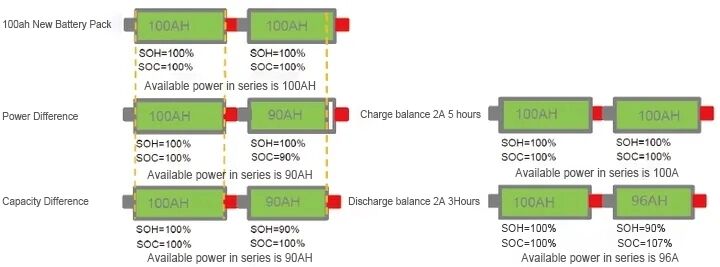The battery system is the core of the entire energy storage system, which is composed of hundreds or thousands of single cells connected in series and parallel.Battery inconsistency mainly refers to the inconsistency of parameters such as battery capacity, internal resistance, and temperature.When inconsistent batteries are used in series and parallel, the following problems will occur:
1) Loss of available capacity
In the energy storage system, single cells are connected in series and parallel to form a battery box, and battery boxes are connected in series and parallel to form a battery cluster. Multiple battery clusters are directly connected in parallel to the same DC busbar.The reasons for the loss of available capacity due to battery inconsistency include inconsistent series connection and inconsistent parallel connection.
· Battery series inconsistency loss
According to the barrel principle, the series capacity of the battery system depends on the single cell with the smallest capacity.Due to inconsistencies such as differences in the individual cells themselves and temperature differences, the available capacity of each individual cell is different. Cells with small capacity are filled first when charging and empty first when discharging, which restricts the charging capacity of other individual cells in the battery system. The discharge capacity causes the available capacity of the battery system to decrease.Without effective balancing management, as the operating time increases, the attenuation and differentiation of the single cell capacity will increase, further accelerating the decrease in the available capacity of the battery system.

· Inconsistency loss of battery cluster parallel connection
When battery clusters are directly connected in parallel, a circulation phenomenon will occur after charging and discharging. The voltages of each battery cluster are forced to be balanced. When the battery cluster with smaller internal resistance is fully charged or discharged, other battery clusters must stop charging and discharging, causing inter-battery cluster charging. Dissatisfaction and inability to discharge the battery will cause battery capacity loss and temperature rise, accelerate battery decay, and reduce the available capacity of the battery system.In addition, due to the small internal resistance of the battery, even if the voltage difference between clusters due to inconsistency is only a few volts, the uneven current flow between clusters will be very large. As shown in the measured data of a power station in the table below, the difference in charging current reaches 75A ( The deviation reaches 42% compared with the theoretical average value), and the deviation current will cause overcharge and overdischarge in some battery clusters; it will greatly affect the charge and discharge efficiency, battery life, and even lead to serious safety accidents.

2) Temperature inconsistency causes accelerated differentiation of single cells and shortened lifespan
Temperature is the most critical factor affecting the life of energy storage. When the internal temperature of the energy storage system rises by 15°C, the system life will be shortened by more than half.Lithium batteries generate a lot of heat during the charging and discharging process. Excessive temperature differences in single cells will cause further increases in internal resistance, capacity, etc., leading to accelerated differentiation of single cells, shortening the cycle life of the battery system, and even causing safety hazards.
How to deal with energy storage battery inconsistencies?
Battery inconsistency is the root cause of many problems in current energy storage systems. Although battery inconsistency is difficult to eradicate due to the chemical characteristics of the battery and the influence of the application environment, it is possible to integrate digital technology, power electronics technology and energy storage technology, and use the controllability of power electronics technology to minimize the impact of lithium battery inconsistency, which can greatly increase the available capacity of the energy storage system and improve system safety.
1) Eitai active equalization technology monitors the voltage and temperature of each single cell in real time to eliminate the inconsistency problem of battery series connection and increase the available capacity of the energy storage system by more than 20% throughout its life cycle.

2) In the electrical design of the Eitai energy storage system, each battery cluster is managed individually for charging and discharging, and the battery clusters are not connected in parallel, which avoids the circulation problem caused by DC parallel connection and effectively improves the available capacity of the system.

3) Accurate temperature control to extend the life of the energy storage system
The temperature of each single cell is collected and monitored in real time.Through three-level CFD thermal simulation and a large amount of experimental data, the thermal design of the battery system is optimized to make the maximum temperature difference of the single cells in the battery system less than 5°C, solving the problem of single cell differentiation caused by inconsistent temperature.
